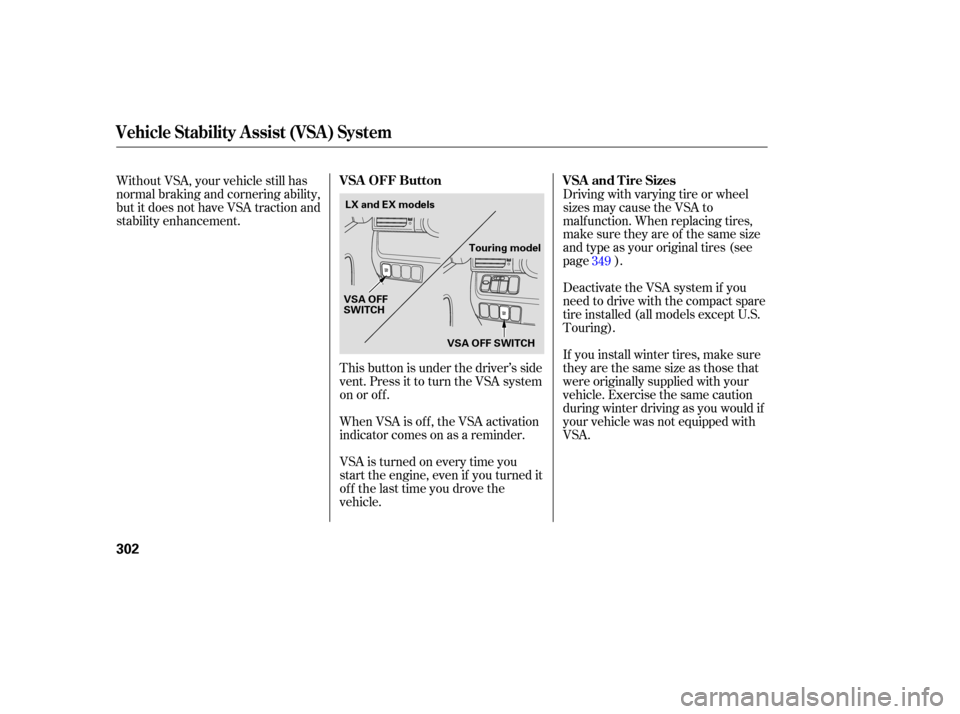Page 64 of 414

The instrument panel has many
indicators to give you important
inf ormation about your vehicle.
See page .If this indicator comes on when the
engine is running, the battery is not
being charged. For more inf ormation,
see page .
On the Touring model, you will also
see a ‘‘CHECK CHARGING
SYSTEM’’ message in the multi-
inf ormation display.
On the Touring model, you will also
see a ‘‘CHECK ENGINE OIL
LEVEL’’ message in the multi-
inf ormation display. The engine can be severely damaged
if this indicator f lashes or stays on
when the engine is running. For
more inf ormation, see page . This indicator has two f unctions:Itcomesonwhenyouturnthe
ignition switch to ON (II). It is a
reminder to check the parking
brake. Driving with the parking
brake not f ully released can
damage the brakes and tires. If it stays on af ter you f ully release
the parking brake while the engine
is running, or if it comes on while
driving, there could be a problem
with the brake system. For more
inf ormation, see page .
If you drive without releasing the
parking brake, a chime will sound.
On the Touring model, you will also
see a ‘‘RELEASE PARKING
BRAKE’’ message in the multi-
inf ormation display.
1. 2.
371 371
372 373
Malf unction Indicator
Lamp Charging System
Indicator
L ow Oil Pressure
Indicator Parking Brake and Brake System
Indicator
Instrument Panel Indicators
Inst rument s and Cont rols
63
U.S. Canada
Page 67 of 414

This indicator normally comes on f or
a f ew seconds when you turn the
ignition switch to ON (II).
If it comes on while driving, it means
that one or more of your vehicle’s
tires are extremely low on pressure.
You will also see a ‘‘LOW TIRE
PRESSURE’’ message on the multi-
inf ormation display. The multi-
inf ormation display will show you
which tire has lost the pressure and
how much pressure it has lost (see
page ).
If this happens, pull to the side of the
road when it is saf e, check which tire
has lost pressure on the multi-
inf ormation display, and determine
the cause. If it is because of a flat tire,
have the flat tire repaired as soon as
possible. If two or more tires are
underinf lated, call a prof essional
towing service (see page ). Formore inf ormation, see page .
Your vehicle has Michelin PAX tires.
Repair or replacement of PAX tires
must be done by a Honda dealer or
an authorized Michelin PAX system
dealer. For more inf ormation, see
page .
This indicator reminds you that the
exterior lights are on. It comes on
when the light switch is in either the
or position. If you turn the
ignition switch to ACCESSORY (I)
or LOCK (0) without turning of f the
light switch, this indicator will
remain on. A reminder chime will
also sound when you open the driver’s
door.
On the Touring model, this indicator
also comes on when the light switch
is in AUTO and the lights turn on
automatically.
303 303
356
381
On U.S. Touring model only On EX and Touring models
Instrument Panel Indicators
Low Tire Pressure
IndicatorLights On Indicator
66
Page 84 of 414
Check Tire PressureWarning: Approaching Object
This message, and the indicator to
the lef t of the message, is a part of
the parking sensor system. If you are
approaching too close to an object,
you will see ‘‘WARNING
APPROACHING OBJECT’’ in the
display and hear a beeper. See page
f or more inf ormation. The f ollowing messages indicate
various problems in your vehicle’s
systems.
If one or more of your vehicle tires
are low on pressure, you will see a
‘‘CHECK TIRE PRESSURE’’
message in the display. See page f or more inf ormation on the tire
pressure monitoring system (TPMS). 303
271
CONT INUED
On U.S. Touring model only
Multi-Inf ormation Display
Inst rument s and Cont rols
83
Page 286 of 414

Some examples are:Larger or smaller wheels and tires
can interf ere with the operation of
your vehicle’s anti-lock brakes and
other systems.
Lowering the vehicle with a non-
Honda suspension kit that
signif icantly reduces ground
clearance can allow the
undercarriage to hit speed bumps
or other raised objects, which
could cause the airbags to deploy.
Raising your vehicle with a
non-Honda suspension kit can
af f ect the handling and stability.
Non-Honda wheels, because they
are a universal design, can cause
excessive stress on suspension
components. Modif ying your steering wheel or
any other part of your vehicle’s
saf ety systems could make the
systems inef f ective.
If you plan to modif y your vehicle,
consult your dealer. See
on page .
Removing parts f rom your vehicle,
or replacing components with
non-Honda components could
seriously af f ect your vehicle’s
handling, stability, and reliability.
35
Modif ying Your Vehicle
Additional Saf ety Precautions
A ccessories and Modif ications
Bef ore Driving
285
Page 287 of 414
�Î�Î�Î�Î�Î
�Î
�Î�ÎYour vehicle has several convenient
storage areas:
In-f loor storage (with Lazy
Susan ) Glove box (upper and lower)
However, carrying too much cargo,
or improperly storing it, can af f ect
your vehicle’s handling, stability,
stopping distance, and tires, and
make it unsaf e. Bef ore carrying any
type of cargo, be sure to read the
f ollowing pages. Roof -rack (if installed) Rear compartment
Center pocket
Removable second row console Rear cargo area, including the
second row seats when removed,
andthethirdrowseatwhenfolded
flat Front door and seat-back pockets
: Touring model only : EX and Touring models only
Carrying Cargo
286
REAR COMPARTMENT FRONT DOOR POCKET
SEAT-BACK POCKET
CARGO AREA LOWER
GLOVE BOX
UPPER GLOVE
BOX
REMOVABLE
SECOND ROW
CONSOLE
CENTER
POCKET
SEAT-BACK POCKETS
IN-FLOOR STORAGE
(with Lazy Susan )
Page 293 of 414
Youshoulddothefollowingchecks
and adjustments bef ore you drive
your vehicle.Make sure all windows, mirrors,
and outside lights are clean and
unobstructed. Remove f rost, snow,
or ice.
Check that the hood is f ully closed.
Visually check the tires. If a tire
looks low, use a gauge to check its
pressure.
Check that any items you may be
carrying are stored properly or
f astened down securely. Check the seat adjustment (see
page ).
Check the adjustment of the
inside and outside mirrors (see
page ).
Check the steering wheel
adjustment (see page ).
Make sure the doors and the
tailgate are securely closed and
locked.
Fasten your seat belt. Check that
your passengers have f astened
their seat belts (see page ).
When you start the engine, check
the gauges and indicators in the
instrument panel (see page ).
3.
2.
1.
4. 5.
6.
7.
8.
9.
10. 16
61
167
149
127
Preparing to Drive
292
Page 303 of 414

This button is under the driver’s side
vent. Press it to turn the VSA system
on or of f .
VSA is turned on every time you
start the engine, even if you turned it
off the last time you drove the
vehicle.Driving with varying tire or wheel
sizes may cause the VSA to
malf unction. When replacing tires,
make sure they are of the same size
and type as your original tires (see
page ).
Deactivate the VSA system if you
need to drive with the compact spare
tire installed (all models except U.S.
Touring).
If you install winter tires, make sure
they are the same size as those that
were originally supplied with your
vehicle. Exercise the same caution
during winter driving as you would if
your vehicle was not equipped with
VSA.
Without VSA, your vehicle still has
normal braking and cornering ability,
but it does not have VSA traction and
stability enhancement.
When VSA is off, the VSA activation
indicator comes on as a reminder. 349
Vehicle Stability Assist (VSA) System
VSA and Tire Sizes
VSA OFF Button
302
VSA OFF
SWITCH
VSA OFF SWITCH
LX and EX models
Touring model
Page 304 of 414
Your vehicle is equipped with a tire
pressure monitoring system (TPMS)
that turns on every time you start the
engine and monitors the pressure in
your tires while driving.
You will see the above display on the
multi-inf ormation display when you
turn the ignition switch to ON (II)
andpresstheINFObuttononthe
steering wheel six times.To see the inf lation pressures of all
f our tires, press the SEL/RESET
buttononthesteeringwheel.The
display changes as shown above.
Each tire has its own pressure
sensor. If the air pressure of a tire
becomes signif icantly low, the
sensor in that tire immediately sends
a signal that causes the low tire
pressure indicator in the instrument
panel to come on. If this happens,
you will see which tire is losing the
pressure in the multi-information
display along with a ‘‘CHECK TIRE
PRESSURE’’ message.
CONT INUED
On U.S. Touring model only
Tire Pressure Monitoring System (TPMS)
Driving
303